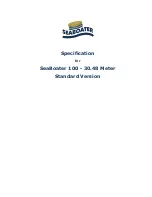
19
In Use
Keep sails out of sun when not in
use by using sail bags and main-
sail cover. If you are a cruiser
using a roller furling genoa, a
leech cover is recommended for
the genoa.
Look out for exposed cotter pins
in the rigging or other sharp
edges to tear the sail. Tape up
where necessary.
When leaving the boat, ease the
halyard on a roller furling headsail
to prevent permanent luff stretch-
ing. Similarly, ease the main out-
haul if the foot is not a loose foot
or shelf design.
Avoid letting sails flog. This dam-
ages the cloth and reduces sail
performance. Adjust the genoa
fairlead and the leech cord to stop
leech flutter. Do not motor directly
upwind with the sails flogging.
Dry sails before stowing them to
avoid mildew. Nylon spinnakers
can bleed color between panels if
stored wet.
Storage on board should be in a
dry, ventilated space away from
hot items such as the engine,
heater or cabin lights. Laminated
sails can be ruined by soaking in
petroleum products such as diesel
or gasoline. If they become
exposed, clean gently with deter-
gent and water, allow to dry and
keep your fingers crossed that you
caught it before the adhesive was
weakened.
Excess heat can distort or weaken
sails. Do not keep them in a
closed car trunk or other closed
container which can build up heat
in the sun.
SAIL CARE & STORAGE
Cleaning
Cleaning sails annually to remove
dirt and salt before winter stor-
age. Take sails to your sailmaker
for washing or wash them yourself
using a mild laundry detergent
and a brush. Do not use excessive
agitation. Dry before folding for
storage.
Oil stains can be treated with a
number of industrial solvents and
even some household spray clean-
ers. For laminated sails, however,
do not use any cleaner more pow-
erful than a household detergents
as they can break down the adhe-
sive in the laminate.
In very damp climates, spraying
Lysol into the sail bag before clos-
ing will help reduce the chance of
mildew.
Mildew should be killed as soon
as it appears to stop it from
spreading. Small areas can be
sprayed with Lysol spray. Larger
areas can be washed with a 25%
solution of Clorox Bleach and
water (NOTE: Kevlar or Nylon sails
should never be exposed to
Clorox!!!). Soak for 15 minutes
and then rinse thoroughly with a
hose. Stains will fade slowly with
sunlight exposure once the
mildew is dead. Storing sails dry in
a well ventilated area reduces the
J/35
Tuning Guide
chance for mildew. Wet roller furl-
ing sails should be rolled up
loosely to allow them to dry.
Maintenance
Small tears in lightly loaded areas
(not near the leech) can be tem-
porarily patched with sail repair
tape or even duct tape to stop the
tear from enlarging.
A few broken stitches probably
won't cause a failure unless they
are near the leech. If they are there,
have the sail restitched before the
seam lets go completely and makes
the repair more difficult.
Take your sails in for an annual
inspection and maintenance. If
this is not practical, spread them
out and look for wear, broken
stitches and rips.
Storage
Store sails for the off season in a
warm dry space away from hot
items like furnaces, hot water
pipes and electric heaters.
Sails should be folded rather than
stuffed to avoid unnecessary
creasing which breaks down the
material.Look out for exposed cot-
ter pins in the rigging or other
sharp edges to tear the sail. Tape
up where necessary.


































